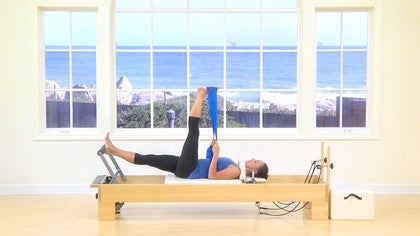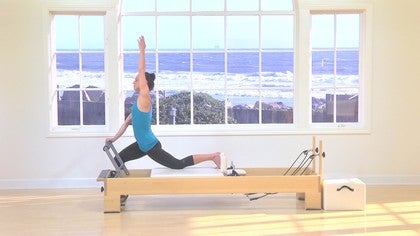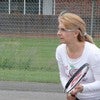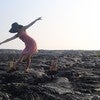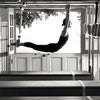Description
About This Video
Transcript
Read Full Transcript
Hi, today we're going to work at a fundamental level and focus on movements that more or less keep us in neutral or extension. So I have the baby arc set up on my reformer and we're going to use that as our warm up. You don't have a baby arc. You could use a Bosu ball or you could choose a different warm up. So lifting tall through the spine. I'm just resting my feet on the foot bar and the inhale here on the exhale, we're going to reach back and now I'm slightly flexing my spine, but I'm thinking of going backwards over the barrel in more of a lengthening contraction, a lengthening movement. I'm gonna lift my arms up, allow my head to drop back, reach my arms around to the sides forward. And then I'm just going to lift my body into neutral here.
So the arms left, the abdominals drop backwards towards the arch. We then reach back, allow the arms to open, there's a little shoulders, chest stretch, and then the arms come forward. And I'm just thinking about bringing my breasts bone into alignment with my ribs. We'll do that one more time. Inhaling the arms reach the spine travels over the barrel. There is a sense of support from the front so I'm not just letting it all go.
The arms reach forward and the breastbone meets the front ribs. From here we're going to reach back and take the hands behind the head. Lining the head up in neutral with this spine makes it a little bit more challenging on the abdominals and in here we stretch back and exhale. We gather up energy from the center of the body and we just hit that nice straight line. Again, neo, we reach back after we left Baca, keeping the head in line with the spine. I like to visualize the two sides of the pelvis, the bones of the pelvis and narrowing and coming towards one another.
In addition there, a visualization of the naval staying connected to the barrel behind us as we reach over the back of it in healing as we stretch and excelling as we lift. Inhaling as we stretch and excelling as we left, reaching forward with the arms and out. Roll the spine up again, not rounding deeply into flection. Okay. We move through some flection to bring the body all the way up and I'm going to turn and place my feet on the floor. Hands are going to come behind the head, right? Create a cradle with my hands for my head. Legs are together on the floor. We'll inhale here. Exhale, we'll turn the spine so we do a lengthening rotation of the spine and inhale to come back to center. Exhale, feel the abdominals draw back towards the spine. The spine lengthens up towards the ceiling. Inhale to center.
I like the visualization of a read you. Those old barbershop pulls are red and whites spirals that continuously travel in an upwardly direction. I think of that when I do movements like this, creating an upward spiral through the spine, the head coming along with this spine, the feet and knees, I'm not shifting, but instead staying still lower, half of the body, still upper, half of the body mobile feel that it's so important for us to have spinal mobility in our lives and this is a good way to practice that safely. So they'll come back to center. We'll spin back around place. If you once again on the foot bar, we're going to do that same action except in a more challenging position.
So we'll roll ourselves down again elongating through this spine. We can either do that with the hands in front. I'm going to choose to reach back and place my hands behind my head. So inhaling here, and then as I exhale, same rotation. I'm supported by the barrel. Inhale to center.
Notice that the head just comes right along with this spine. It doesn't turn in my hands. Inhale to center. Excellent. As we rotate around and inhale to center and reaching out through the spine. So now instead of thinking about reaching upwards, I'm thinking about reaching backwards and center and across. This is strong as a challenging exercise. For sure.
We'll do one more to each side center. Last time center will reach the arms forward and now will reach all the way back for the last time, allowing the spine to have a final stretch, reaching the arms around to the sides and lifting the body in a lengthening way back up to sitting. So I'm going to take that barrel away. I've already set my springs up for footwork work. I'm working with three reds in a blue spring today and I have a Sarah Band handy that I'm going to use in a little bit. So we're going to lie down all the way and then place the feet on the bar hip distance apart in a find. Settle into a neutral pelvic position. Settle into straight arms heavy ribbons and inhale, moving on through footwork or press the carriage back on the exhale and we'll bend the knees to breathe in.
Focusing here again on the long positioning and the spine. It's nice to initiate with a little downward drag of the heels, a little downward drag. And as the legs press out each time we involve the center of the body just by heavying up the ribs, working with the breath. So we exhale the carriage back and inhale. And as the legs are straightening, make sure that the knees stayed just in front of the ankles.
And then as that straightening occurs, the quadriceps are very active. The feeling of lifting the kneecaps away from the shinbones last time, reaching out and bending and moving to the toes, wrapping the toes around the bar, pressing out. Stay here for just a moment and feel that the heels are lifted as much as they can without the ankles rolling out or rolling and rolling out as a more. Um, what tends to happen more than rolling in from there, we recreate long spine and then we keep the spine very long as the knees bend. And I think to think about here is trying to keep this spring long is even as they're shortening. So as the knees bend, we're resisting.
We want to try to keep the springs as long as we can for as long as we can. The heels from that high lifted position when I'm in straight knees, just stay very still in space so they don't lift up and down. And in focusing on this, it's enabling us to use the muscles in our feet and keep the ankle in a neutral, in a set of a locked position. We'll do two more here. Every so often it's nice to check in with the neck. See that there's no excess tension there.
Let's move into a small v-shape and continue moving to check in with the arms and the shoulders and see that there's no excess tension there. Feel the heels pressed together to gather energy all the way up through the inner thighs to the pelvis. That energy can then be carried on through the center of the body and perhaps even out the top of the head. The arms are reaching for the seat as the knees reach back towards the fingers. We'll do three more here. So moving through all of our footwork positions.
Nice long neck,
Remembering that [inaudible]
We'll stay here and we'll press out and bend.
And from here we'll take the heels down. Now feel as the heels go under the bar that this is a focus on lifting all the way up into the glute. And then we rise up and we take the heels down. So as we lift up again, it's a focuses on officiant movement through the foot, so in articulatory pattern and good alignment of the ankle joints. So the ankle joints lie straight or the ankle area lies both as the heels drop down under the bar. And also as the heels lift up, we'll do five more as the feet are moving down. And up. Continue to reach the arms forward. Continue to check in with the deck. So just settling in, feeling the backsides of the legs working last two times and last time we'll bend the knees and come back and pressing out again.
Bend the left knee and drop the right heel under the bar. Drag down deeply into that stretch and then lift under both feet and change and lift and change so the feet meet in the middle and a high position. Notice here, the pelvis, the stillness of the pelvis. It's not rocking from side to side. It's not lifting up and down. It's staying glued to the reformer.
As the work happens through the knee and through the ankle. Joints do about three more to each side, really pulling against or with the spring into the stretch that the springs are at helping you provide. Well, we never want to get lazy. We always want to work with the springs to maximize that downward reach. Last time, lifting the heels and bending the knees, so turning onto our side will help ourselves up. I'm going to change a spring for single leg. Take two reds in a blue.
If I had a student and I was just the teacher, I wouldn't have them get up and down for this. I would just change the spring thing. He didn't hand them their band. So what we're going to do here is we're going to keep the right foot on the bar. We're going to take the left foot and we're going to put it in the band. So what we're wanting here is for the left leg to find a stretch.
Now not everyone's going to be able to be vertical, so we could even bend that knee a little bit or we could drop it slightly forward from here. Looking again for stability, we're gonna press out using the right leg, left leg stays lifted. We could even, if you want it to increase, the stretch could reach through the heel of that foot all the time, reaching out and bending and reaching and bending. And we'll do three more. I've got my arms resting against my body, close to me, the shoulders. There's a concentrated effort of holding the shoulders down and back, bending the knee to come in. And then take that right foot, slide it into the band, take the left foot and put it on the bar, lining it up with the sitting bone on the right on the left side. Excuse me.
Finding the place where the pelvis can be a neutral, and then the left leg presses a very simple movement. Choreographically but lots of things that could go wrong or could be looked for, right? Or is the pelvis sitting level is the leg that's in the air, taking it to maximum stretch or other ribs heavy? Are the shoulders pulled away from the shoulder blocks? Do to more stretching all the way out and bend and stretching all the way out.
The right foot comes onto the bar. I'm going to stay on the right toes and we're going to change the, the movement of the leg here. So instead of staying still, that left leg is going to move through space. So as I press out with my red, like I'm gonna bring my left leg towards me just to the point where I can keep stillness in the hips. And then I'm gonna bend and lower that leg down, not so low that the band gets in my way. And we're gonna press and reach out. Maintaining the integrity of the foot throughout press and reachout and Ben. Press and reach out. Shoulders sliding down the back as the leg lifts up.
So each time we just look for a little deeper stretch, we'll do two more reaching up and back. And last one I can think of pulling the leg towards your body, like single straight leg stretch with the abdominals and ending back in exchanging feet again. Right foot goes into the band, left foot goes on the bar, elbows into the waist. And here we go. Pressing out or organizing that left foot and then letting the right leg lower, pressing out, seeing strong, strong through this spine, checking in, uh, both sides of the pelvis equally heavy. It's also interesting to notice or to ask internally or to your student if one side feels significantly easy or, or different than the other. It's a good way the single leg work of gathering information.
So we're going to bring the arms just in front of the shoulders and then from there we're going to float the legs into a tabletop position. So the thinking here as the arms press down to the sides of the body as though you're pressing with the intention of lifting the body into flection, that's an exhale. Inhale as we lift the arms up and resist. So the pressure of the arms feels as though that's coming from a forwardly pulling sternum or from downwardly pulling ribs as though the sliding down of the ribs could buy that by itself. Move the arms. In addition to that, you can create a little imaginary wall against the front of the thighs and you could push the front of the fives into that imaginary wall. So now we've got force coming from a hip flection and shoulder extension.
And just by creating that forth, we should all be feeling the center of the body working fairly deeply. Posit the bottom. Turn the palms in. Inhale to reach the arms out. Same focus XL, sliding the ribs teak ever as the arms come in in here. Feel the ribs, not lift off the Mat, but lifts. Reach sideways as the arms deep and exhale to press. Inhale as you reach our keeping the shoulders, reaching down excellently.
Slide the arm and press then into the body as the arms going out. And also in, think about the abdominals or the belly button. Just getting heavier and heavier like the mat is quicksand and the body sinking into the quicksand. We'll do one more in your open and exhale to press. Then lift the arms up.
Keep the shoulder blades still as you open the arms out to this side. That'll help you keep the carriage still and press down. Rotate the palms down at the bottom, lift the arms up, keep the shoulders stable, inhale and exhale. So we inhale as the arms come up and exhale as a pressed down. All the while putting all that focus into the quicksand heavy abdominals.
Quick sand, heavy ribs. We'll do one more like this, open and press. From there, we'll reach the other way. We reach out to the side, lift the arms above the shoulders and press straight down. Reach out to the side. Keep the carriage still apply. A little forward pressure into the straps all the time with what? The hands? Nope, the center of the body.
So we just continue to bring our awareness over and over again into that center connection. If you get lost, look for it again. Follow the breath.
So again, where can we think about, we can think about the rib cage dropping and as the ribs drop, the belly button gets heavier. We have that a little imaginary wall to press against with the size, right? So creating work pressure, sensation control from all directions
Press out on the bar with your legs and bring one foot into the strap. Press out with that leg, taking the other foot into the strap. [inaudible] bring the knees into a bent position. Settle the tailbone down between the legs. Breathe in and as you breathe out, pull back with the abdominals. Almost delay the movement of the fee because you're pulling so much back through the trunk. And then the legs will slide out. Stray.
Feel the connection of the heels again, sliding through the shins, through the upper inner thighs, through the waist, through the rib cage. It's Nice controlled movement, soft movement, feeling the rotation in the hip joints and outwardly rotation of the femurs
Going as low as you can with good stability in the trunk. Inhale as the legs lift up. Exhale as we press away with the knees and just him that action's a hinge at the pelvis. Lifting up on the inhale, wrapping and pressing on the exhale jacking again with the arms and shoulders with the backsides of the ribs. So now we're going to add on. We're going to stay at the bottom. We're going to stretch the legs out, almost barely moving. The reformer in a, lift the legs up in a wrap the knees outwardly and then the knees back into that diamond position and then press down again. Stretch the legs out, pulling backwards through the center of the body, attempting to not move. The reformer eight might move a little bit, but it's possible to barely move it at all.
And then wrapping the knees back and exhale, press and reach. And then in to lift
As we reached down and together, watching as the legs separate that they separate equal distance to one another and then they reach down and together in here, notice if one of your legs tends to want to come faster to the center than the other. So there's a lot of space here for personal exploration. Last two, as the legs come towards the body, the pelvis reaches down and back saying all the time, just in that nice neutral line, going to take that in reverse. Now we're going to go out around to the top, click the heels together and press. So there's a freedom in the circle. An exclamation point is the like, find each other again and they move down together.
We'll do three more reaching around and [inaudible]
So we bring the foot up against the shoulder blocks. We find the hands against the foot bar and staying pretty high up for just a moment. I want you to feel that the pubic bones reaching up towards the belly button with that sensation in place. Then start to move this phi bone backwards and then with your arms, feel as though you're lifting your spine away from the bar and settle into that stretch for a couple of breaths.
Draw in on the abdominals. Keep now the pelvis on the same line, but we're going to think about arching the spine, going to reach that front leg out. So now we're stretching the front leg, pausing and breathing. I've lifted my front foot off the floor.
Squared front leg is flexing off the floor in a bend, the front near and a lift the body in and up. Step down and walk to the other side. So now we placed the left foot on the reformer or the opposite foot on the reform. I don't know whether I specified one or the other on the last one, but we know what we're doing. We're working the other side, stretching the other side. So again, you look for that little rotation in the pelvis from the rotation in the pelvis. That five of impresses back the arms are actively pushing into the bar to help you stay lifted through your spine. And we breathe.
We bring the carriage all the way in and we stepped down. I'm going to keep that spring. We're going to do a little reverse knee stretch with a flat spine today, so I want us to do that as come up against the shoulder blocks with our knees. Place our hands just on the frame of the reformer. Let's over indulge the arch of the lower spine just for a moment so that we can back up into a more neutral pelvic position from that place.
Feel a down and back. Pull with the arms. Same as we were doing when we were lying on our back and in and up, pull with the waist. And from that place we just slide the knees underneath us without changing the spine. Inhale as we let the knees come back, XL engaging through the waste, thinking about pulling the legs up with our breath from all the way up under the rib cage. Inhale, as we release, exhale as we pull two, three, four. And really, so I'm doing it [inaudible] very slow, very conscientious movement. And again, I'm checking in with both sides of my body on the side of my body that doesn't feel like it gets as significant of work as the other side. I give that knee that side, a little extra pressure against the reformer, that arm, a little extra attention. I'm just gonna do two more. So pulling and releasing and stabilizing through the shoulders. Pulling in.
Yeah, and really see. So allowing the carriers not to come all the way back. We'll just sit back trying to keep this spine long in the back, a little stretch. We'll come up and grab the box. [inaudible] place the box short ways.
From there we find a long line in the body. Long line in the body head comes into alignment with this spine. It's a little upward press into the strap so we are very actively working that upward side and I like to think about using that bottom arm to help me lift and find my underneath carriage. Then keep my up arm on my thigh. All I'm going to do here is just take that arm away holding five, four, three, two, one and as I placed my hand back down, I again accentuate the upward pull of the bottom rib and we do that again. We hold fi, so just being in this position, teaching the body how to find this line is a great preparatory exercise for learning the full side over at a later date.
Reaching out [inaudible]. It also starts to lift that arm, lift that bottom bar or not. Okay. And we're gonna put the hand down. I'm gonna put the elbow down, resting the elbow on the Heteros when take that up arm and just reach overhead. And now we make a rainbow with the bottom ribs and we stretch that arm. Let me bring the hand back. I'm gonna use it to help ourselves up. We'll do the other side. So changing feet, bringing the knee up onto the box, elongating out through that leg, that's going to be straight or free. I'm just wrestle alongside the body, helping us find that line. The bottom arm helps us find our underneath carriage.
And then we just simply let go. Two, three, four, five and we rest and we realign and let go. Two, three, four, five. And we rest one more. Holding. One, two, three. [inaudible] deciding to lift that bottom arm and makes it harder.
Just the weight of that arm against gravity. Hand down. The elbow comes down onto the headrest, the top arm reaches out overhead, and we just [inaudible] succumb to that stretch. Well, that's how I feel in the stretch anyway. It's a beautiful stretch. One of my favorites as a matter of fact. So we're going to help herself back up and step down.
Now we're going to take this spring down, two one blue. I'm gonna turn the box and here's where we're going to get that band again. Well I'm finished with a little back extension, so I'll do a front view and a side view of what I'm looking for here and start with the band. So holding the band with the sums or you can even just wrap the hands around so that the hands themselves hold the band looking for straight wrists, straight fingers, straight spine. And all we're gonna do here is allow the band to get pulled apart by the rotation in the upper arm. And as we do that, we're just allowing the eyes and the breastbone to lift towards the ceiling.
So it's a small movement and I'm putting the focus here, my opera spine. So as I think about rotating the arms, just that allows my chest just the tiniest little moment. I'm not shifting from my pelvis. Holding the pelvis is very still, and then we return back to straight. It's a great back extension exercise again, sliding the hands apart, rotating the upper arms in the shoulder joints, lifting the chest up and returning back to stray. What about three more sliding now turning in the shoulder joint, sliding out with the arms, lifting the chest up and returning back to straight.
One more time. We reach up and we return back to straight letting the band. I'm just gonna fold it up and let it rest on my lap for now. We'll come back to it and just a second. Taking the straps with the hands. I'm going to do a very similar action with the body here.
So I'd like for you to think about first is creating a significant downward heaviness that says as though the hands, arms are being pulled into. Let's say that quicksand image again. And as that happens we're going to start to draw back on the arms. And as that peds again, we're going to allow the breastbone to lift. So it's again chest expansion with a little bit of upper thoracic extension. As the arms come back to our sides, we return the body to an upright position.
As we begin to find heaviness through the shoulders, we begin to find lightness in the spine. As the arms begin to move the chest, the breasts bone lifts up at the abdominals. Drawbacks so much towards the spy, and then we return again, maximizing the extension, not in the lower spy. The lower spines. Make the remaining still thinking of maximizing the extension in the opera spine. One more downward reach or heaviness, upward elongation or lightness. Two energies, very oppositional energies happening at the same moment. Then moving through the arms, bringing the arms back forward and reaching down to a place to straps back.
Taking the band again. Again, I'll show a front and a side view of this is how we take that band. I'll give yourself a quite a bit of space actually, so we're going to lift the arms up, just bringing the arms to where the shoulders can comfortably manage. Then we're going to bend and as we bend our elbows, we're going to bias towards trying to bring the elbows towards the band, towards the floppy part of the band. Now not everyone will go all the way behind them. Not everyone will even go this far back with their arms initially and then we are gonna reach the arms up and back and we're going to take the arms down.
But that's not important. What's important as that, we start getting movement in that direction and that as we've been the elbows, the elbows don't press back behind the hands, but instead buy this forward or just underneath the hand, not really pulling on the band a little bit, but I am a little and then as we reach up with the arms, spine can come with us and we'll bring the arms back in front. We'll do two more with a side view there. So reaching the arms on, let's inhale here. Exhale, bending the elbow has held, was reaching towards the band, little back extension. They're not from the pelvis. Reach back up and take the arms forward and inhale to lift XL to bend. And extend. I feel so beautiful and heel to reach out and exhale lower
[inaudible] that the spine is elongating and floating and then the arms can just drop down and then flex through the heels of the hands. Press Open with the arms generating energy from behind the body, feeling an outward reach through the arms and then stop pressing and let the arms just start floating up towards the ears and down and
Pilates with Meri Rogers: Reformer Workouts
Comments
I don't have the arc so I used my spine corrector on the floor instead :)
@ Jill, I have never liked lifting my headrest up for any work so I didn't even notice Merediths was down until I read your question. I am interested in the technical answer but prefer the comfort of my headrest down.
My goal in this class was to keep the spine either in neutral or extension. Elevating the cervical spine while lying in a supine position takes the spine out of neutral which is why I left the headrest down. That being said, although I often lift my headrest to during footwork to check alignment and such, I also like to practice with it down to feel the natural alignment of the entire spine.
I am so glad you were able to find a creative way to do the first part of the class....a spine corrector, a ball, a bosu...all arc shaped, all effective for the intention of the movement.
You need to be a subscriber to post a comment.
Please Log In or Create an Account to start your free trial.
